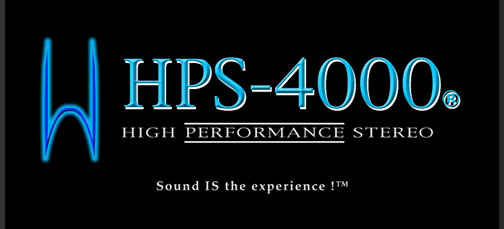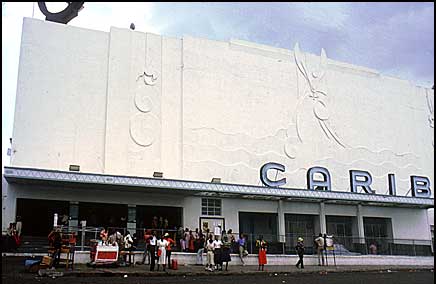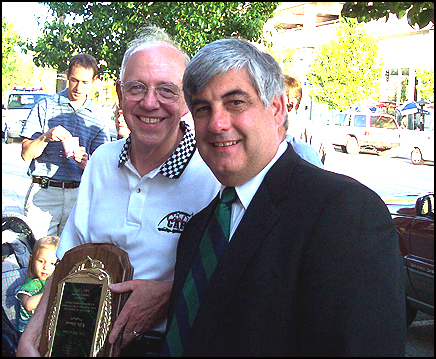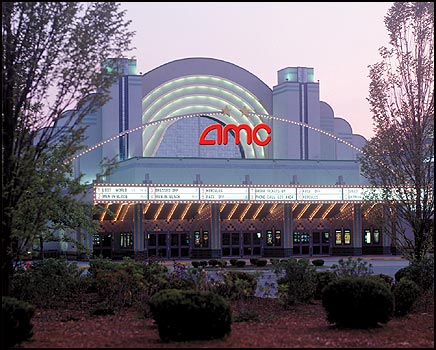 |
|
CASE STUDIES ILLUSTRATE HOW HPS-4000® SOUND SYSTEMS INCREASE THEATRE ATTENDANCE  THE COMMUNITY PLAYHOUSE Ever since the very first installation of the prototype of the HPS-4000® motion picture sound system in 1980, the audience response has been strong. Back then, the HPS-4000® name and trademark had not been introduced. It would be another 4 years for a formal name to be chosen. Yet even without any brand identification, audiences recognized the unprecedented sound quality afforded by this new and extraordinary sound system. In 1979, the single screen Wellesley Community Playhouse in Wellesley, Massachusetts had already been a local fixture for decades. Customer support had remained good but attendance had been flat for sometime and was beginning to drop. The owner felt that if something wasn’t done, the business could be at risk. There were several options to consider. But in the end, it was decided to install a new stereo sound system. This, even though at the time only 15 to 20 percent of the films were being released in stereo. Unfortunately, when visiting other cinemas, the owner found that the stereo equipped theatres sounded unsatisfactory and, most notably, dramatically inferior to even modest home stereo systems. The surround speakers were particularly annoying. More often than not a listener felt attacked by the surrounds rather than feeling surrounded. This is not the kind of experience that would attract an audience, let alone an audience in an upscale area. The distortion heard in stereo theatres was another issue. It was decided that it would be totally unacceptable to install a stereo sound system in the Community Playhouse unless the results would be significantly superior to those found in any other movie theatre. Something better would have to be done even though it meant that the upgrading of the theatre would be delayed. About a year later, the first prototype of the HPS-4000® sound system premiered at The Community Playhouse and was an immediate success. The clarity and dynamic range of this new system exceeded all expectations. And the surround coverage afforded by the newly invented ALLEN SURROUND ARRAY™ proved to be so uniform throughout the theatre, that no one in the audience could localize to any single surround speaker. Within the first year, attendance at the theatre increased by 25 percent. Not long after, BOSTON MAGAZINE named the Community Playhouse the BEST FILM HOUSE, noting its unequaled sound quality. The following year the honor was repeated, naming the Playhouse the BEST SUBURBAN THEATRE. It wasn’t long before this theatre gained the reputation as the place to experience a film.  THE PALACE AMUSEMENT COMPANY’s CARIB THEATRE The Carib Theatre in Kingston, Jamaica opened in 1938 as a large single screen theatre. At 180 feet long, 85 feet wide and 65 feet high, it was one of the larger theatres in the world. In the decades that followed, the theatre served as one of Kingston’s major cultural facilities as well as the city’s largest auditorium. In the early 1980’s, the Palace Amusement Co., owners of the Carib, was straining under the competition presented by video piracy and a growing number of home theatres. Business at the theatre was going nowhere. Under the leadership of the company’s managing director, Douglas Graham, it was decided to upgrade the mammoth theatre’s motion picture presentation system. Recommendations were solicited from industry experts. The advice they received ranged from suggestions that no sound system could possibly work in such a big theatre and that it should be cut up into three theatres, to statements that the audience wouldn’t know the difference between a really good system and a minimal system with only 100 watts per channel. These ideas were rejected as soon as they were offered. After attending a theatre owner’s convention, Douglas Graham realized that only an HPS-4000® sound system was capable of the performance required for his huge theatre. Believing in his customers, Graham was also convinced that the impressive sound quality would indeed attract a greater audience. At this same time, Palace’s competition operated the Regal Theatre, just up the street from the Carib. Though not as large as the Carib, the Regal was almost as large. Regal’s management evidently received the same kind of advice for their theatre as did Palace. Unfortunately, Regal’s management decided to believe those who said that a minimal 100 watt per channel stereo system would suffice and that the audience either didn’t care or would not know the difference. Both theatres underwent their respective upgrades at the same time. Both theatres also premiered their new sound systems at the same time. Regal opened with the Jamaican premiere of RAIDERS OF THE LOST ARK. The Carib was not quite so lucky. It was opening with two “B” pictures. One was called SEVEN and the other was entitled DOGS. When the dust settled, the Carib had out-grossed the Regal. Carib’s attendance grew 20 percent in the first year following the installation of the most powerful HPS-4000® in the world. Regal’s business eventually dropped to the point that its owners asked Palace to take it over. But it was too late. To try to steer patrons up the street to the Regal, Palace sometimes ran the same picture in both theatres. If Carib sold out, they would offer discounted tickets for those who would be willing to go up the street to the Regal. But they would not go. Preferring to wait two hours, in the rain if necessary, people would only see their movies at the Carib. Today the Regal is a shopping center. The increase in business at the Carib had some other benefits for the Palace Amusement Company. It was not only able to fund additional upgrades to its flagship theatre, Palace Amusement was also able to build new screens for the first time in years, including Jamaica’s first multiplex. The sound quality of the HPS-4000® had saved the company. The Carib quickly became the highest grossing theatre in the entire West Indies. Indeed, following a string of unprecedented grosses, the management’s view of their business evolved into thinking of themselves as not in the movie business, but in the sound business. Further information on the Carib Theatre including, an article by Douglas Graham, may be found in the Articles and Papers section of this web site. Click on the Installations file.  CLASSIC CINEMA’s CINEMA 12 Located in Carpentersville, Illinois, Cinema 12 was built in the 1960’s as a twin theatre complex by one of the largest major theatre circuits. Two additional new auditoriums and splitting one of the original theatres eventually brought the screen count to five. Competing theatres in the area were limited. In 1990, the theatre, then named “Cinema 5,” was taken over by Tivoli Enterprises, owners of Classic Cinemas. When Classic Cinemas took over the complex it removed the mono sound systems and immediately installed five HPS-4000® sound systems as well as new projection and automation systems. In the first year of operation with the new sound systems the theatre saw an attendance increase of over 125,000 patrons. Since then, the theatre has been able to completely revamp all of the facilities and, more importantly, was able to support the addition of seven more screens. It is now called Cinema 12. All 12 theatres are equipped with HPS-4000® sound systems. Cinema 12 no longer enjoys being the only major theatre in the area. Since its expansion, two major complexes have opened against it. Yet with its superior HPS-4000® sound, Cinema 12 is still holding its own and, unlike other theatres of its vintage, remains profitable. 
THE 1928 HPS-4000® EQUIPPED TIVOLI THEATRE AS IT IS TODAY. WILLIS JOHNSON AND THE MAYOR OF ELMHURST, IL |

